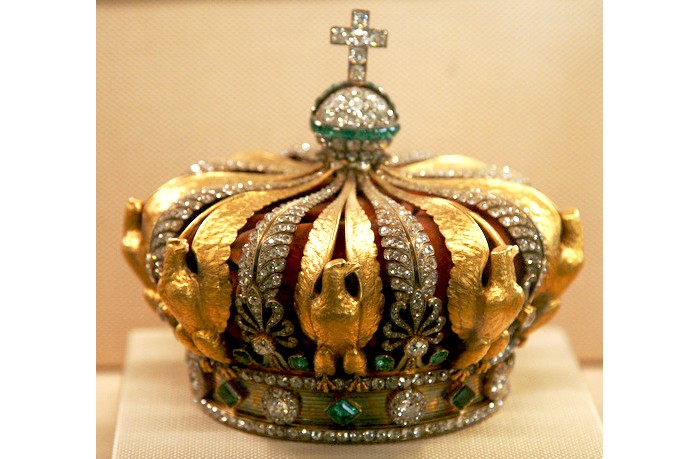Crown of Empress Eugénie, wife of Napoleon III
This is the Imperial crown of Empress Eugénie, the wife of the Emperor Napoleon III – the nephew of Napoleon Bonaparte, whose reign had been decisively ended by the Battle of Waterloo in 1815. By 1852, Napoleon’s heir had established a second French Empire, and he was keen to exploit the symbols and mythology of Napoleon I to gain popular support. This crown’s use of golden eagles directly refers to the Eagle Standards carried by French regiments during the Napoleonic Wars.
Eugenie, Countess de Teba (born 1826), was the daughter of a Spanish nobleman who had fought for the French in the Peninsular War. This crown was made for her as the Empress Eugenie, consort of Emperor Napoleon III, whom she had married in January 1853.
Napoleon III, also known as Louis Napoleon, was a nephew of Napoleon Bonaparte, who had been deposed as Emperor of France after his defeat at the Battle of Waterloo in 1815. In April 1848, after two attempts to restore Bonapartism in France had failed, the French people rose up against the monarchy, part of a wave of revolutions across Europe. In December Louis Napoleon he was elected president of the Second Republic, using his uncle’s reputation and promising to restore the glory of France. Three years later he overthrew the republic and created the Second Empire. He was crowned emperor on 2 December 1852, 38 years to the day since his uncle’s coronation.
Eugenie’s imperial crown, 13cm high and 15cm in diameter, was a centrepiece at the 1855 Paris Universal Exposition. Crafted principally by Alexandre-Gabriel Lemonnier, it was based on a pattern from the imperial arms of the First Empire. Eight eagles of gold form arches which alternate with laurel leaves emerging from palmettes (a motif of fan-shaped palm leaves). The latter are composed of diamonds with a larger diamond in the centre. They are flanked by two emeralds. Surmounting this structure is a globe, also made from diamonds, and incorporating a circle of emeralds. The piece is topped with a cross made from six brilliants. In all, the crown boasts 2,480 diamonds and 56 emeralds.
The new era of Napoleonic glory which the crown was intended to reflect did not last. On 11 January 1871, following defeat in the Franco-Prussian war, the Third Republic was proclaimed. The royal couple found exile in Britain. The former emperor died in 1873. He is buried at St Michael’s Abbey, Farnborough.
His son, the Prince Imperial lies near him. The Prince had been killed fighting to protect the British Empire against the Zulus in 1879. Eugenie continued to live for many years at Farnborough Hill. Part of her house was used as a hospital for wounded officers during the Great War. Though she died in Madrid, 11 July 1920, her body too was interred at Farnborough.
-
Curatorial info
- Originating Museum: Louvre Museum, Paris
- Production Date: 1855
- Creator: Alexandre-Gabriel Lemonnier
- Material: Gold, diamonds, emeralds, flet
-
Use this image
You can download and use the high resolution image for use in a non-profit environment such as a school or college, but please take note of the license type and rights holder information below
- Rights Holder: Image created by David Liuzzo
- License Type: Creative Commons







